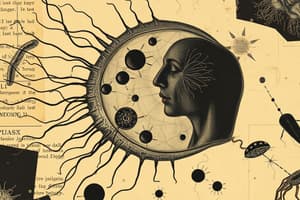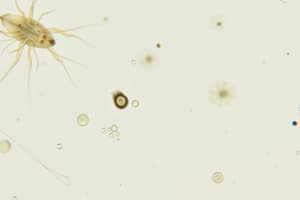Podcast
Questions and Answers
Which genus includes the causative agent for malaria?
Which genus includes the causative agent for malaria?
- Paramecium
- Trypanosoma
- Euglena
- Plasmodium (correct)
Which protist is a concern because of its ability to contaminate water supplies and cause diarrheal illness?
Which protist is a concern because of its ability to contaminate water supplies and cause diarrheal illness?
- Trichomonas vaginalis
- Plasmodium vivax
- Giardia lamblia (correct)
- Toxoplasma gondii
A fluke is classified within which of the following?
A fluke is classified within which of the following?
- Annelida
- Platyhelminthes (correct)
- Nematoda
- Rotifera
A nonsegmented worm is found during a routine colonoscopy of an individual who reported having abdominal cramps, nausea, and vomiting. This worm is likely which of the following?
A nonsegmented worm is found during a routine colonoscopy of an individual who reported having abdominal cramps, nausea, and vomiting. This worm is likely which of the following?
A segmented worm has male and female reproductive organs in each segment. Some use hooks to attach to the intestinal wall. Which type of worm is this?
A segmented worm has male and female reproductive organs in each segment. Some use hooks to attach to the intestinal wall. Which type of worm is this?
Mushrooms are a type of which of the following?
Mushrooms are a type of which of the following?
Which of the following is the most common cause of human yeast infections?
Which of the following is the most common cause of human yeast infections?
Which of the following is an ascomycete fungus associated with bat droppings that can cause a respiratory infection if inhaled?
Which of the following is an ascomycete fungus associated with bat droppings that can cause a respiratory infection if inhaled?
Which polysaccharide found in red algal cell walls is a useful solidifying agent?
Which polysaccharide found in red algal cell walls is a useful solidifying agent?
Which is the term for the hard outer covering of some dinoflagellates?
Which is the term for the hard outer covering of some dinoflagellates?
Which protists are associated with red tides?
Which protists are associated with red tides?
You encounter a lichen with leafy structures. Which term describes this lichen?
You encounter a lichen with leafy structures. Which term describes this lichen?
Which of the following is the term for the outer layer of a lichen?
Which of the following is the term for the outer layer of a lichen?
The fungus in a lichen is which of the following?
The fungus in a lichen is which of the following?
The plasma membrane of a protist is called the __________.
The plasma membrane of a protist is called the __________.
Animals belong to the same supergroup as the kingdom __________.
Animals belong to the same supergroup as the kingdom __________.
Flukes are in class _________.
Flukes are in class _________.
A species of worm in which there are distinct male and female individuals is described as _________.
A species of worm in which there are distinct male and female individuals is described as _________.
Nonseptate hyphae are also called _________.
Nonseptate hyphae are also called _________.
Unicellular fungi are called _________.
Unicellular fungi are called _________.
Some fungi have proven medically useful because they can be used to produce _________.
Some fungi have proven medically useful because they can be used to produce _________.
Structures in chloroplasts used to synthesize and store starch are called ________.
Structures in chloroplasts used to synthesize and store starch are called ________.
Algae with chloroplasts with three or four membranes are a result of ________ ________.
Algae with chloroplasts with three or four membranes are a result of ________ ________.
Eukaryotic microbes include which of the following?
Eukaryotic microbes include which of the following?
What are protozoa?
What are protozoa?
Describe the life stages of protozoa.
Describe the life stages of protozoa.
How do protozoa reproduce?
How do protozoa reproduce?
What are the main protozoan cell structures?
What are the main protozoan cell structures?
What are the feeding structures of protozoa?
What are the feeding structures of protozoa?
What locomotion structures do protozoa typically have?
What locomotion structures do protozoa typically have?
What are some unique organelles found in protozoa?
What are some unique organelles found in protozoa?
What are the prominent groups of protozoa?
What are the prominent groups of protozoa?
What characteristics define the amoebozoa group?
What characteristics define the amoebozoa group?
What are the two life cycles of slime molds?
What are the two life cycles of slime molds?
What is a common characteristic of Chromalveolata?
What is a common characteristic of Chromalveolata?
What is the major distinguishing feature of Apicomplexans?
What is the major distinguishing feature of Apicomplexans?
What are key members of Chromalveolata?
What are key members of Chromalveolata?
What are the characteristics of fungi?
What are the characteristics of fungi?
What are the two major fungi structures?
What are the two major fungi structures?
Name the main phyla of fungi.
Name the main phyla of fungi.
Flashcards are hidden until you start studying
Study Notes
Malaria and Protozoa
- Causative agent of malaria is Plasmodium.
- Giardia lamblia is a protist that contaminates water and causes diarrheal illnesses.
- Protozoa are unicellular and can have trophozoite (active) and cyst (dormant) life stages.
Helminths
- Flukes are classified under the phylum Platyhelminthes.
- Non-segmented worms found during colonoscopy are likely nematodes.
- Cestodes are segmented worms that may have hooks for attachment and possess reproductive organs in each segment.
Fungi Characteristics
- Mushrooms are structured as basidiocarps.
- Candida albicans is the most common cause of human yeast infections.
- Histoplasma capsulatum is an ascomycete fungus linked to bat droppings, causing respiratory infections.
Algal Structures and Types
- Agar is a polysaccharide found in red algal cell walls, useful as a solidifying agent.
- The outer covering of some dinoflagellates is called the theca.
- Dinoflagellates are associated with red tides.
Lichens
- Leafy-structured lichens are referred to as foliose.
- The outer layer of a lichen is termed the cortex.
- Fungal components in lichens are generally ascomycetes.
Protozoa Cell Structures
- Protozoa exhibit unique structures like plasmalemma (membrane) and pellicle (rigidity).
- Feeding via cytostomes with cilia to direct food, or through cytoprocts for waste excretion.
Protozoa Mobility and Organelles
- Locomotion is enabled by cilia, flagella, and pseudopodia.
- Contractile vacuoles help in osmoregulation, with some protozoa having modified mitochondria (e.g., hydrogenosomes).
Major Protozoan Groups
- Prominent protozoan groups include Amoebozoa, Excavata, and Chromalveolata.
- Amoebozoa include species like Entamoeba histolytica, a cause of dysentery.
Fungal Diversity
- Fungi include groups such as Ascomycota, Basidiomycota, Zygomycota, and Microsporidia.
- Ascomycota are associated with human pathogens (e.g., Candida albicans).
Helminths Classification
- Helminths are classified into roundworms (Nematoda) and flatworms (Platyhelminthes).
- Nematodes include species like Ascaris lumbricoides, the largest human roundworm.
General Fungi Characteristics
- Fungi are heterotrophic and mostly saprozoic, existing in forms like molds and yeasts.
- Yeasts are unicellular and reproduce asexually via budding.
Life Cycles and Reproduction
- Fungi can reproduce sexually or asexually, utilizing mitosis or budding methods.
- Many fungi are significant decomposers and have complex life cycles.
Important Terms
- Unicellular fungi are termed yeasts.
- Coenocytic hyphae lack septa, while septate hyphae contain compartmentalized structures.
Video and Graphics Note
- Mitochondria may be absent or modified, potentially indicating adaptations to anaerobic environments among some protozoa.
Studying That Suits You
Use AI to generate personalized quizzes and flashcards to suit your learning preferences.




